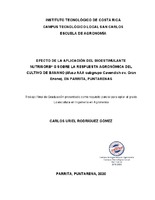Efecto de la aplicación del bioestimulante Nutrisorb® G sobre la respuesta agronómica del cultivo de banano (Musa AAA subgrupo Cavendish cv. Gran Enano), en Parrita, Puntarenas
Resumen
El presente ensayo se realizó con la finalidad de analizar la respuesta
agronómica del cultivo de banano (Musa AAA subgrupo Cavendish cv. Gran Enano),
ante la incorporación del bioestimulante Nutrisorb® G en el programa de fertilización
del cultivo de banano. El estudio fue desarrollado en Finca San Gerardo, ubicada
en Parrita de Puntarenas, a partir de noviembre del año 2018 (inicio de la estación
de verano) y finalizando en octubre del año 2019 (finalizando la estación de
invierno). Los tratamientos correspondieron a la variación en la frecuencia de
aplicación del bioestimulante Nutrisorb® G, en una misma dosis de 8 Kg/ha. El
testigo de finca (T1), representó el programa nutricional utilizado en la finca sin la
adición de ningún otro componente. Los tratamientos T2, T3 y T4, correspondían a
la aplicación de bioestimulante en frecuencias de aplicación definidas cada nueve,
doce y quince semanas, respectivamente. Se evaluó el crecimiento absoluto y la
tasa de crecimiento (altura, circunferencia del pseudotallo y emisión de hojas) de
los hijos de sucesión, el contenido de nutrientes foliar y de la cáscara del fruto, el
porcentaje de incidencia y porcentaje de afectación por mancha de madurez, el peso
del racimo, el índice de retorno y el rendimiento estimado del cultivo. Los resultados
indicaron un comportamiento semejante en el crecimiento del cultivo, tras la
aplicación del bioestimulante. Además, se observó que la condición nutricional de
la plantación al momento de la evaluación fue semejante en todos los tratamientos.
El tratamiento de aplicación de Nutrisorb® G cada doce semanas, mostró una
reducción no significativa (p=0,0601) en el porcentaje de incidencia de mancha de
madurez, correspondiente a un 18,96% en relación con el testigo de finca en
semana 35. El porcentaje de afectación de mancha de madurez cuando se aplicó
cada quince semanas fue estadísticamente superior al testigo de finca en semana
35 (p=0,0042). El peso del racimo y el índice de retorno, mostraron un
comportamiento semejante en todos los tratamientos. El rendimiento estimado al
incorporar el bioestimulante cada doce semanas, indicó un incremento no
significativo de 370 cajas/ha/año sobre el testigo (p=0,0513) en semana 30. The present trial was carried out with the purpose of analyzing the agronomic
response of the banana crop (Musa AAA subgroup Cavendish cv. Gran Enano),
before the incorporation of the biostimulant Nutrisorb® G in the fertilization program
of the banana crop. The study was developed at Finca San Gerardo, located in
Parrita, Puntarenas, from November 2018 (beginning of the summer season) to
October 2019 (ending the winter season). The treatments correspond to the variation
in the frequency of application of the Nutrisorb® G biostimulant, in the same dose of
eight kilograms per hectare. The farm control (T1) represents the nutritional program
used on the farm without the addition of any other component. The T2, T3 and T4
treatments correspond to the application of biostimulant at defined application
frequencies every nine, twelve and fifteen weeks, respectively. The absolute growth
and growth rate (height, pseudostem circumference and leaf emission) of banana
suckers, the content of foliar nutrients and fruit peel nutrients, the percentage of
incidence and affectation due to maturity bronzing, the weight of the bunch, the rate
of return and the estimated yield of the crop were evaluated. The results indicated
a similar behavior in the growth of the banana crop, after the application of the
biostimulant. In addition, it was observed that the nutritional condition of the
plantation was similar in all treatments. Nutrisorb® G application treatment every
twelve weeks, showed a non-significant reduction (p = 0.0601) in the percentage of
incidence of maturity bronzing, corresponding to 18.96% in relation to the farm
control in week 35. The percentage of stain affectation of maturity bronzing when
applied every fifteen weeks was statistically higher than that of the farm control at
week 35 (p = 0.0042). The bunch weight and the return index showed a similar
behavior in all the treatments. The estimated yield when incorporating the
biostimulant every twelve weeks, indicated a non-significant increase of 370 boxes
per hectare per year over the control (p = 0.0513) in week 30.
Descripción
Proyecto de Graduación (Licenciatura en Ingeniería en Agronomía) Instituto Tecnológico de Costa Rica. Escuela de Ingeniería en Agronomía, 2020.


